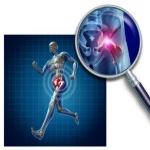
Low back and hip pain can stem from a variety of sources. Symptoms and their location can help to determine what in fact is the cause of the source of pain. Low back pain could be caused from strain due to injury, overuse, disc pathology, pinched nerves, or even kidney infections. There are bones, muscles, ligaments, and a variety of other structures that could be damaged acutely or even over time. Most often, symptoms include a dull ache or a sharp pain, pain with movement of the back, tenderness to touch, sciatica or shooting pain down either or both legs, muscle spasms, or pins and needle like sensations in the legs.
Osteoarthritis of the spine typically causes pain that is worse in the back and the buttock region. It progresses over time and periods of inactivity increase symptoms which these improve with activity. Check out tips to maintain a healthy back here.
Hip pain can often mimic low back pain with what is called referred pain, or pain that is felt at a site other than where the cause is located. Osteoarthritis most commonly effects the hip joint and is felt in the groin or inner thigh, close to the pelvic region. Pain on the outside of the hip and thigh are most likely related to soft tissue structures such as a muscle or a tendon. Osteoarthritis occurs when the protective covering over the ends of the bone in the joint wears down with aging and prolonged high impact activities.

Osteoarthritis worsens over time and increases pain and stiffness in the joint. Typically, a simple x-ray is enough to diagnose osteoarthritis of the hip. Once diagnosed, there are many treatment options available to discuss with your doctor. Many conservative methods are used, including oral anti-inflammatories, cortisone injections, PRP injections, and physical therapy. A doctor will determine the most appropriate treatment course given the x-rays and the severity of symptoms reported. Joint replacement is also performed on those who have failed conservative treatment options with prolonged symptoms.
By: Riki Duncan, MA. Ed, ATC, LAT
Sources:
http://www.webmd.com/back-pain/tc/low-back-pain-symptoms
http://www.mayoclinic.org/diseases-conditions/osteoarthritis/home/ovc-20198248

